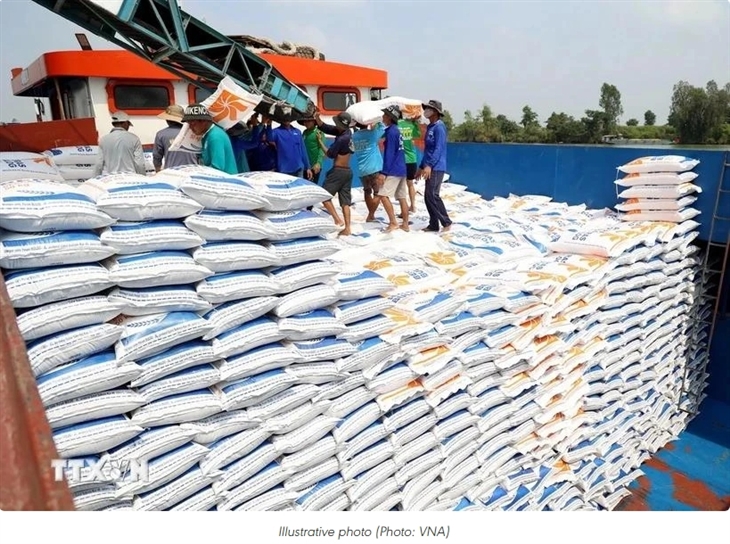Indian expert suggests ways for Vietnam to boost rice exports
Friday, October 11,2024
AsemconnectVietnam - Improving the rice quality, diversifying markets, and building a recognisable and trustworthy brand identity for Vietnamese rice are among measures for Vietnam to boost its rice exports, said Secretary of All India Spices Importers Federation (AISIF) Hiren Gandhi.
Improving the rice quality, diversifying markets, and building a recognisable and trustworthy brand identity for Vietnamese rice are among measures for Vietnam to boost its rice exports, said Secretary of All India Spices Importers Federation (AISIF) Hiren Gandhi.
In an interview granted to Vietnam News Agency correspondents in New Delhi, he said Vietnam needs to make its rice meet international standards, including developing high-quality rice varieties with specific characteristics to cater to different markets; work to grasp the distinct preferences and needs of consumers in different markets; and strengthen cooperation with local farmers to ensure consistent quality, promote sustainable farming methods and support them to access the latest advances in agriculture.
It is necessary to invest in advanced processing technology to improve the quality of rice products, including new techniques in milling, preservation and packaging; actively participate in market research and trade promotion activities to better understand consumer demand, market trends and pricing strategies in different regions, he noted.
Finally, Gandhi emphasised the need to ensure products meet strict international food safety and traceability standards, which are increasingly important to consumers and regulators, he added.
With these above specific strategies, Vietnamese rice exporters can further consolidate their position in the global market and continue to achieve impressive growth, according to him.
Regarding India's decision to lift the ban on exporting regular white rice and set a floor price for this item at 490 USD per tonne, the expert said it has had a strong impact on the global rice market in general and that in Vietnam in particular. India is the second largest rice producer in the world, just after China, with an annual output of 118 million tonnes, while Vietnam produces 21.2 million tonnes. India exports 16.5 million tonnes of rice each year, while Vietnam ships 7.6 million tonnes yearly.
Gandhi noted that the two countries have great potential for cooperation in this field, especially for brown rice. Vietnamese importers should import brown rice from India, process it in Vietnam and then export it globally, he recommended./.
Source: en.vietnamplus.vn/indian-expert-suggests-ways-for-vietnam-to-boost-rice-exports-post298066.vnp
In an interview granted to Vietnam News Agency correspondents in New Delhi, he said Vietnam needs to make its rice meet international standards, including developing high-quality rice varieties with specific characteristics to cater to different markets; work to grasp the distinct preferences and needs of consumers in different markets; and strengthen cooperation with local farmers to ensure consistent quality, promote sustainable farming methods and support them to access the latest advances in agriculture.
It is necessary to invest in advanced processing technology to improve the quality of rice products, including new techniques in milling, preservation and packaging; actively participate in market research and trade promotion activities to better understand consumer demand, market trends and pricing strategies in different regions, he noted.
Finally, Gandhi emphasised the need to ensure products meet strict international food safety and traceability standards, which are increasingly important to consumers and regulators, he added.
With these above specific strategies, Vietnamese rice exporters can further consolidate their position in the global market and continue to achieve impressive growth, according to him.
Regarding India's decision to lift the ban on exporting regular white rice and set a floor price for this item at 490 USD per tonne, the expert said it has had a strong impact on the global rice market in general and that in Vietnam in particular. India is the second largest rice producer in the world, just after China, with an annual output of 118 million tonnes, while Vietnam produces 21.2 million tonnes. India exports 16.5 million tonnes of rice each year, while Vietnam ships 7.6 million tonnes yearly.
Gandhi noted that the two countries have great potential for cooperation in this field, especially for brown rice. Vietnamese importers should import brown rice from India, process it in Vietnam and then export it globally, he recommended./.
Source: en.vietnamplus.vn/indian-expert-suggests-ways-for-vietnam-to-boost-rice-exports-post298066.vnp
Vietnamese PM delivers speech at ASEAN Business and Investment Summit
US issues preliminary anti-subsidy findings on solar panel imports from Vietnam
WEF leader holds talkshow with young entrepreneurs, students in HCM City
Enhancing connections critical to exploiting FTAs: seminar
Vietnamese, Japanese businesses promote technology supply-demand connection
Top leader’s visit opens new door for Vietnam – Ireland trade: insiders
PM Chinh applauds Meta's contributions to Vietnam - US ties
Vietnam, China hold 13th session of Economic and Trade Cooperation Committee
Indonesia-Vietnam business forum unlocks new cooperation frontiers
Petrovietnam signs MoUs on digital transformation, sustainable energy with US partners
ADB remains upbeat about Vietnam’s economic prospect
Japan helps Vietnam improve stock market’s transparency
Thailand is Vietnam's largest export market in ASEAN
Top leader’s trip expected to open up more opportunities for Vietnam-US trade ties


